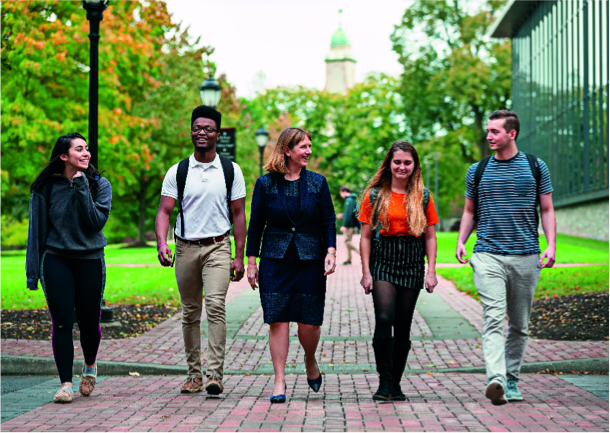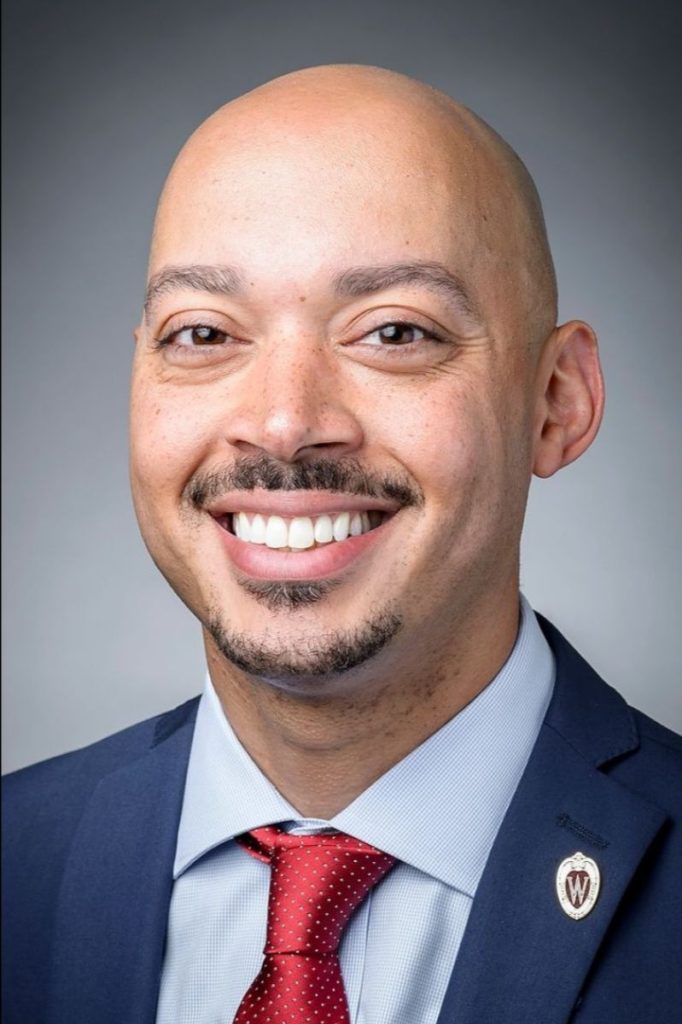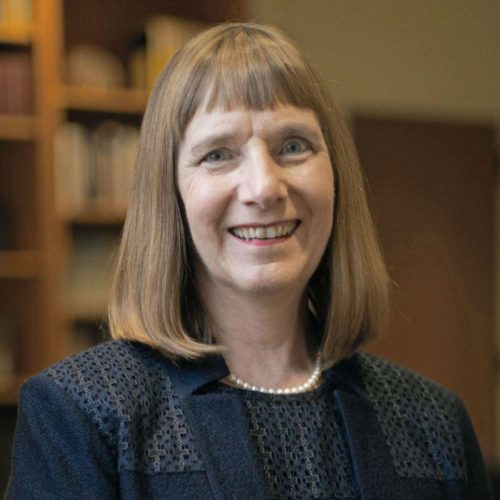
Quarterly Newsletter
Welcome to The American Talent Initiative quarterly newsletter – your source for news and insights on how we’re working toward our 50,000-by-2025 goal.
Presidential Perspective: Alison Byerly, Lafayette College

Lafayette College is working to grow its financial aid budget to support increased socioeconomic diversity. We spoke with President Alison Byerly to learn how this work is unfolding.
We constructed a plan that involved multiple sources to support increased financial aid. One of them, of course, is fundraising. Another is taking the first percentage point off the top of any tuition increase and putting that directly into financial aid, in addition to what we had previously been doing. But a third and important component of our plan was growing the size of our student body by 400 students over the course of six to eight years.
Q: What inspired you to become involved with the American Talent Initiative?
A: The formation of ATI could not have been better timed for what we were hoping to accomplish at Lafayette. We were in the process of launching a strategic direction premised around the idea of increased affordability, an initiative we call Affordability and Distinction through Growth. As the ATI effort was beginning, I benefitted from a lot of the early publicity and commentary about other institutions’ work and how ATI hoped to advance all of our efforts by giving us the opportunity to think about them as part of a larger collaborative effort.
When I came to Lafayette, I recognized that as strong as the college was, we weren’t keeping pace with the financial needs in our applicant pool; we were turning away talented students because we didn’t have enough aid to give. So as ATI was formed, I was able to use it as an example when talking to my board and community and say, “Look, this is now recognized as an urgent, national project. College and university presidents all across the country have the same notion, which is that we’re letting finances stand in the way of too many talented students’ education.”
Q: In last year’s American Talent Initiative Impact Report, increasing the size of the student body was cited as a strategy members used to expand opportunity for lower-income students. While most examples came from larger, public institutions, you have pursued this strategy at Lafayette, a smaller, private college. Why have you pursued this strategy? What advice do you have for smaller colleges considering this?
A: Growth has been foundational to our effort to become more affordable. We had a very strong applicant pool and recognized if we could increase tuition revenue, we could use those resources for financial aid. We constructed a plan that involved multiple sources to support increased financial aid. One of them, of course, is fundraising. Another is taking the first percentage point off the top of any tuition increase and putting that directly into financial aid, in addition to what we had previously been doing. But a third and important component of our plan was growing the size of our student body by 400 students over the course of six to eight years. We calculated that the amount of infrastructure we would need to add would not increase costs in a way that was proportional to the revenue we gained by having those additional students.
Our strategic direction is premised on the idea that this was the right moment for Lafayette to grow – that we had the capacity, we had the enrollment interest. And I would say to other colleges that every school is in a different place and has to judge for itself what its capacity is. But we have found that the energy and momentum we have built by adding more students and expanding the faculty have worked together to create a lot of positive momentum.
One of the questions that comes up on campus all the time is whether or not we’re doing enough to support the students we’re bringing in. As we bring in more students with more diverse socioeconomic backgrounds, our campus is constantly asking if we are doing everything we can for those students. We have been very engaged over the course of the last year or two in developing specific plans to support various underrepresented student groups and in gathering input from the community about places where they might feel that growth has created strains.
It is important to recognize when doing this work that growth is inherently challenging. It asks a lot of the community to be bringing in lots of new people and making them a part of that community. Making sure there is as much community conversation as possible about things like where we might need new staff or if we need more academic space has been very important. We had done a lot of planning, but it had happened more behind the scenes, and now we’ve had to lift the curtain and bring that conversation out into the community as a whole to give them confidence that we’re really ready for the community that we’re building.
Q: You mentioned “lifting the curtain” and involving others in the conversations about providing students with support and making sure growth is sustainable and inclusive. What does that look like in practice?
A: We’ve used a couple of different strategies. In the last year, one thing that was very helpful was we held a retreat with our board of trustees, a group of thirty or so faculty leaders, and some administrative staff. They all engaged in substantive discussions about how the strategic direction was going. This was not framed as an update on everything that was great; we picked out three areas that were particularly challenging and had workshops focused on those challenges. The board has committed to doing another retreat this year and potentially every year, just as they did last year because having the board, faculty, and administrative staff talk collectively turned out to be really powerful.
Q: Being “need-blind” in admissions is often an important component of expanding access. It remains an aspiration for many schools, Lafayette included. In the meantime, how can a school be—as one of your enrollment leaders put it—“responsibly need aware?”
A: We actually started out by saying that our goal was to become need-blind and our plan calculates what level of financial aid we think we need to get us there in 2026. But what we have found along the way is that being sensitive to what levels of need are represented in our pool is actually helpful in building the kind of socioeconomic diversity we want. In a way, being need-blind is a kind of proxy for having a socioeconomically diverse student body. It’s a very important flag to be able to plant and say that is where we want to be. But we would fully acknowledge that we are not there yet. Most of our admissions decisions aren’t affected by level of need, but there are some really tough calls made toward the end of the admissions process that really do come down to a set of folders that are students who can pay full price and a set of folders that are students who need what is left of our financial aid budget.
 What we really grapple with is: what does “responsibly need-aware” mean in terms of practice? Our admissions folks found it contradictory at first, but as we try to focus on being more accessible to students with need, we actually pay more attention to need. For example, we do still have some remaining merit aid and a merit fellowship program that is high-level and competitive. We now look at need as well as merit in awarding those merit scholarships, which we hadn’t done previously. We’re factoring need in in a more positive way and really trying to use every bit of information we have to figure out how we can have the greatest impact on the largest number of students.
What we really grapple with is: what does “responsibly need-aware” mean in terms of practice? Our admissions folks found it contradictory at first, but as we try to focus on being more accessible to students with need, we actually pay more attention to need. For example, we do still have some remaining merit aid and a merit fellowship program that is high-level and competitive. We now look at need as well as merit in awarding those merit scholarships, which we hadn’t done previously. We’re factoring need in in a more positive way and really trying to use every bit of information we have to figure out how we can have the greatest impact on the largest number of students.
A metaphor I used in my initial presentation to the board back in 2016, which now has become a regular part of the repertoire, is that becoming need-blind is like hiking up a mountain. You hope to get to the very peak, but the view gets better all along the way. Every step you take forward is giving you that broader view that you’re looking for. That doesn’t mean that you’re not still hoping and expecting to reach the summit, but it’s not as if the distance between here and there is a waste. Every step you take is an improvement.
Q: You mentioned merit aid. How do you think about striking the right balance between merit and need-based aid to accomplish ATI-related goals?
A: I would say that our objective has been to reduce our dependence on merit aid over time. We give many fewer merit awards than we did four to five years ago, and we changed to a competitive process that involves students coming to campus to be interviewed. A small number are selected as an honorific cohort, as opposed to the merit award simply being experienced as a discount coupon. We felt that we could be more comfortable retaining the level of merit that helps us remain competitive among our peers when it was really positioned not as discount off the tuition but as a genuine scholarship that students have won for specific excellence we can identify.
Q: We’ve heard—especially from smaller, more tuition-dependent private colleges—that maintaining a particular discount rate can sometimes come into tension with goals of advancing access and affordability for lower-income students. Nearly half of ATI’s progress to our 50,000-by-2025 is contingent on small private colleges increasing or maintaining commitments to access and opportunity. Can ATI goals be achieved without increasing the overall discount rate at tuition-dependent institutions? How have you navigated these conversations, in particular with your board of trustees?
When I first came to Lafayette, I recognized that our board was very proud of having a lower discount rate; it was then around 33-34%. They felt that in a time when a lot of schools’ discount rates were creeping up that we had to keep this budgetary item under control. They were somewhat taken aback when I said that this would actually be a problem; we would be a stronger institution and have stronger students if we raised the discount rate.
A: Our strategy actually was premised on the idea that increasing the discount rate would be a critical backbone of the plan. When I first came to Lafayette, I recognized that our board was very proud of having a lower discount rate; it was then around 33-34%. They felt that in a time when a lot of schools’ discount rates were creeping up that we had to keep this budgetary item under control. They were somewhat taken aback when I said that this would actually be a problem; we would be a stronger institution and have stronger students if we raised the discount rate. Our plan now focuses on slowly raising that rate and we’ve been going at about one percent a year, so we’re now at about 39%. But within that discount rate, there are so many different ways to distribute aid that different institutions will naturally have different approaches and I think there’s certainly improvement that can be made even if you’re not undertaking the more radical shift that we’re making, or what will feel like radical by the time we get there. We hope to be closer to the mid- to high-forties or higher by the end of the plan. That will be a big difference for us. But we think that for Lafayette that really represents a commitment of resources that needs to be made to bring in the strongest students. I would add that we have found in the three years of the plan so far that it has demonstrated that hypothesis beautifully. In each of the three years of the plan we have had the highest SAT and ACT scores we’ve ever had and also the most diverse student body. So that definitely proves that more financial aid gives you access to more talented students.
I would say that what worked best with our board was to appeal to their competitive instincts, which most boards of trustees have. I was able to point out that what separates us from the schools we aspire to resemble is that they are spending more on financial aid and they’re able to bring in stronger students for that reason. When I said we could bring stronger students and be a stronger school and look more like the schools we aspire to look like, that was compelling. And that’s again why ATI was so helpful. It allowed me to go to board meetings with an actual list of top schools in the country that are doing the exact same thing. That really hammered home the argument that this is what the best schools try to do, and we want to be considered among the very best schools.
Q: From everything you’ve learned about increasing access for low- and moderate-income students, what would you like to share with other ATI presidents? Particularly those at similar institutions?
A: I would just say that I value the collegial spirit behind ATI and the effect of having so many presidents trying to move in the right direction. I think we recognize that competitive forces can often move us in the wrong directions, so I feel very pleased and proud that we’re able to make some steps that we think are not only benefitting us competitively as an institution but more importantly benefitting a larger number of students. And I certainly encourage everyone who is on this same path to continue to look critically at the ways in which we deploy our aid, to try to look beyond the pressures of a particular enrollment cycle and look long term. We’re making a long-term investment that is a difficult climb for us right now but that will put us in a stronger position in the future, and we recognize that that’s what is important in this kind of difficult moment for higher education. I applaud the efforts that everyone is making to advance from whatever place they are to a better place. As institutions, we’re all in different places and I think that being able to share our experiences can be tremendously valuable.
UW-Madison on Fundraising for Need-Based Financial Aid

UW-Madison is working toward a $3.2 billion fundraising goal, with a major focus of the effort being need-based student aid. We spoke with UW-Madison Director of Student Financial Aid Derek Kindle to learn more about the university’s fundraising strategy and to share advice to other institutions hoping to increase philanthropic support for need-based aid.
Hire well. Have a lot of data available and be nimble in modifying language and data visualizations for those who want high-level information and who are not seeking to run a university or become a financial aid expert overnight.
Q: How do UW-Madison’s fundraising priorities relate to its ATI-related goals?
A: UW-Madison’s All Ways Forward Campaign challenges the institution to raise $3.2 billion, and student support is a big part of that—especially need-based student aid. This level of financial support is aimed at making UW-Madison accessible for first-generation students and students from low- to moderate-income households. Our need-based aid goals also span the wide array of financial needs for our students beyond tuition and fees. We are keenly interested in providing our students with funding for summer enrollment, study abroad, and for other needs they may have. We hope to enable them to enroll, persist, and graduate with the least amount of debt (ideally, no debt) and with opportunities that will not only help them graduate on time, but also provide them with a set of experiences that makes them competitive in the post-graduation environment, whether they intend on attending graduate/professional programs or entering the workforce.
Q: What unique challenges does fundraising for financial aid present in comparison to other fundraising priorities? Have you faced any challenges to the work so far that you did not expect?
A: Fundraising for financial aid can be both challenging and really simple. The simple part is that there is immediate and direct impact in a very relatable way with donors. Many of our donors give because of their own experiences or experiences of others they know, and because they want to have the greatest impact to live on in future generations. The challenge with fundraising for financial aid is identifying potential donors with both high capacity and high affinity specifically for financial aid, yet general enough interest to not simply rest with a school, college, or department. At UW-Madison, like many other campuses, deans have historically had the primary relationships with high-capacity donors, and sometimes that means that the needs of their own school, college, or department may be more specific than that which fits into an overall financial aid strategy. At UW-Madison, we are fortunate to have our own Director of Development (DoD) whose primary responsibility is to identify donors who may have both capacity and affinity to give to student scholarship support. This requires a great deal of cooperation, partnership, and trust with deans and development directors that sit within the schools and colleges. We had to identify a great DoD who could relay our needs to donors and could also be self-starting in brokering relationships with team members across a very large and complex organization.
Q: As you mentioned, UW-Madison has a Director of Development for Scholarships and Student Experience embedded in the Office of Financial Aid. Tell us a bit more about this organizational structure. What potential issues does it resolve and what advantages have you seen since implementing this change?
A: Having our own Director of Development has meant that we are now able to carve out a name and place for those donors interested in student support and for those who are looking to directly impact certain causes. The DoD reports to the Wisconsin Foundation and Alumni Association with a reporting line to the Director of Student Financial Aid. This relationship works just like any other DoD relationship with a dean. It provides the Office of Student Financial Aid with the particular advantage: it can not only better steward scholarship funds but also provide information about needs that stretch across campus and that are not based only within a school, college, or department. Since implementing this change, we have increased student scholarship support, and also established relationships with DoDs across campus who now have to a direct partner to be able to answer questions and provide information for those donors who want to directly support students.
Q: If another university came to you for advice about raising $100,000,000 for need-based financial aid, what recommendations might you give?
A: Hire well. Have a lot of data available and be nimble in modifying language and data visualizations for those who want high-level information and who are not seeking to run a university or become a financial aid expert overnight. Have your priorities with specific “price tags” available on a per student basis and be ready to steward in a more personalized way. Have your data-sharing agreements and philosophy on how to work with donors established before going into the campaign and be flexible as it may need to change throughout the campaign. Get your financial aid director on board early and keep them engaged often to so you are able to demonstrate the greatest needs and best administration and stewardship of funds. This is new territory for many aid directors, so having conversations early, often, and with full transparency is a must. Aid directors should be open to corresponding with and traveling to meet donors locally, off campus, or wherever the donors may be available. There is the added advantage of aid administrators, who know and serve students directly regarding their financial needs, who are able to have a relationship with students, which helps build the case for additional support and donor cultivation. The stewardship could include a wide array of student-facing activities like collecting “thank you” letters to assisting in having students meet the people who have contributed to their success.
CollegePoint Partnership Opportunity

CollegePoint—Bloomberg Philanthropies’ companion effort to the American Talent Initiative—has a new opportunity to enable ATI members to connect with and recruit more high-achieving, low- and moderate-income students. Continue reading for an overview of CollegePoint and learn how you can work with them this year.
CollegePoint Overview
CollegePoint is a coalition of nonprofit organizations and philanthropic institutions with the goal of increasing the number of high-achieving, low- and moderate-income students enrolling in top colleges from 1/3 of 75,000 students in 2014 to more than 1/2 by 2020. Through this coalition, 50 full-time and over 600 volunteer virtual advisors use technology to support high-achieving, low- and moderate- income students in applying to and enrolling in colleges that match their qualifications.
CollegePoint Phone Book
CollegePoint advisors and students are always eager to connect directly with contacts at ATI member institutions who typically work with and understand our student population. Our population includes students from all 50 states who have test scores in the 90th percentile or higher, a GPA of 3.5 or higher, and a family income of less than $80,000 per year.
To help forge connections, CollegePoint is creating a “Phone Book” of admissions staff who work with high-achieving, low- and moderate-income students and can serve as a main point of contact for questions. This Phone Book will only be shared with CollegePoint advisors and students and will not be publicized. If your institution is interested in learning more about the CollegePoint model, additional information is provided in the link below.
I’m interested, but I have more questions → Please email CollegePoint’s Director of Strategic Partnerships, Dimity Palmer-Smith at dimity.palmer-smith@americaachieves.org.
Welcome to Our Newest ATI Members
Welcome to ATI members who joined the initiative between January and September 2019!
- Connecticut College
- Denison University
- Drexel University
- George Mason University
- Massachusetts Institute of Technology
- Miami University-Oxford
- Texas A&M University
- Trinity College
- University of Notre Dame
- University of Pittsburgh
- University of St. Thomas
- William & Mary
Milestones & Key Dates
ATI 2019 Strategic Support Meeting
June 18, 2019
The ATI team held its largest Strategic Support Meeting yet this past June in Washington, D.C, with 106 representatives representing 99 total institutions in attendance. Thank you to all of those who attended for your continued partnership in ATI's work!
ATI 2019 Data Collection Submissions
We’d like to take this opportunity to thank all of our members for submitting their 2019 data – we now have 100% of the submissions! We rely on these data to measure our collective progress, and we look forward to sharing insights from the aggregated data.
If you have any questions about the ATI data collection, please contact Emily Schwartz.
ATI Practice-Sharing Webinar: Follow-Up Blog Post
The ATI team wrote a blog post as a follow-up to our webinar: Supporting Postsecondary Access and Success for Rural students.
Transfer & Veterans Communities of Practice Convening
October 29-30, 2019
The ATI team held its first communities of practice convenings in Washington, D.C. last week, with one day devoted to the veterans community and one day devoted to the community college transfer community. Thank you to the ~85 participants who attended! We look forward to welcoming more ATI members to future CoP convenings.
UPCOMING EVENTS:
ATI Practice-Sharing Webinar Series
November 19, 2019 | 2:00-3:00pm
Please register here for ATI's webinar: Improving Clarity in the Financial Aid Offer
Please contact Gelsey Mehl with any questions.
ATI 2020 Presidential Summit
March 11, 2020
New York, N.Y.
Please register here.
Please contact Benjamin Fresquez and Yazmin Padilla with any questions.
If you would like to include an announcement or other information in the ATI newsletter, please contact McKenzie Maxson.
In the News
- President Speaks: How to ease transfers between two- and four-year colleges, by President Eric F. Spina, The University of Dayton
- Opinion: Three ways to help more underrepresented students graduate from college, by Richard Whitmire
The American Talent Initiative
Author
-

The American Talent Initiative (ATI) is a Bloomberg Philanthropies-supported collaboration between the Aspen Institute's College Excellence Program, Ithaka S+R, and a growing alliance of colleges and universities dedicated to substantially expanding opportunity and access for low- and moderate-income students. ATI members—all graduating at least 70 percent of their students within six years—have joined together to address this challenge.
View all posts
Related posts:
 Presidential Perspectives: Alison Byerly, Carleton College (and formerly Lafayette College)
Presidential Perspectives: Alison Byerly, Carleton College (and formerly Lafayette College)
 Incorporating Equity into Fall Reopening Plans
Incorporating Equity into Fall Reopening Plans
 The Ohio State University President Kristina Johnson: Funding and Sustaining a No-Loan Approach to Increase Affordability
The Ohio State University President Kristina Johnson: Funding and Sustaining a No-Loan Approach to Increase Affordability



